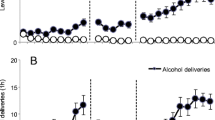Abstract
Noradrenergic neuronal hyperactivity following chronic morphine administration has been postulated to cause withdrawal signs and symptoms. Suppression of this hyperactivity, for example, by clonidine attenuates withdrawal. It might follow, therefore, that the prevention of suppression of noradrenergic systems during chronic morphine administration might diminish hyperactivity and prevent withdrawal. If the normalization of noradrenergic activity during opioid administration did not also suppress analgesia, it might be of medical and theoretical interest. To test this hypothesis, we gave the alpha-2-antagonist yohimbine to rats in order to increase noradrenergic activity during morphine treatment and then subsequently precipitated morphine withdrawal with naloxone. Six groups were examined: saline controls (N=11), morphine (N=11), morphine + 2.0 mg/kg/day yohimbine (N=15), morphine + 3.0 mg/kg/day yohimbine (N=5), 2.0 mg/kg/day yohimbine (N=11) and 3.0 mg/kg/day yohimbine (N=5). Subjects received 75 mg morphine pellets implanted on day 1,4 and 6 of the treatment or sham implantation. Yohimbine was delivered throughout the morphine treatment by subcutaneously implanted osmotic pumps. On day 7, all subjects were given 1.0 mg/kg naloxone and rated for behavioral signs of withdrawal. Analgesia was measured by observing tail flick latencies (TFL) before and after chronic drug treatments. Naloxone-precipitated withdrawal was characterized by irritability, ptosis, penile erection, diarrhea, rhinorrhea, abnormal posture, wetdog shakes, jumping, and teeth chattering, none of which were observed in groups receiving only saline or yohimbine. Withdrawal behavior was attenuated in a dose-dependent manner when yohimbine was administered during morphine treatment but analgesia was not attenuated. It appears that yohimbine-induced antagonism of alpha-2-adrenergic receptors diminishes the development of the potential for adrenergic hyperactivity and morphine withdrawal without reducing opioid analgesia.
Similar content being viewed by others
References
Aghajanian GK (1978) Tolerance of locus coeruleus neurons to morphine and suppression of withdrawal response by clonidine. Nature 276:186–188
Bird SJ, Kuhar MJ (1977) Iontophoretic applications of opiates to the locus coeruleus. Brain Res 122:523–533
Blasig J, Reinhold HK, Zieglgansberger S (1973) Development of physical dependence on morphine in respect to time and dosage and quantification of the precipitated withdrawal syndrome in rats. Psychopharmacologia 33:19–38
Britton KT, Svensson T, Schwartz J, Bloom FE, Koob GF (1984) Dorsal noradrenergic bundle lesions fail to alter opiate withdrawal or suppression of opiate withdrawal by clonidine. Life Sci 34:133–139
Cedarbaum JM, Aghajanian GK (1976) Noradrenergic neurons of the locus coeruleus: inhibition by epinephrine and activation by the alpha-antagonist piperoxane. Brain Res 112:413–419
Cedarbaum JM, Aghajanian GK (1977) Catecholamine receptors on locus coeruleus neurons: Pharmacological characterization. Eur J Pharmacol 44:375–385
Charney DS, Heninger GR (1986) Alpha-2-adrenergic and opiate receptor blockade. Synergistic effects on anxiety in healthy subjects. Arch Gen Psychiatry 43:1037–1041
Charney DS, Stemberg DF, Kleber HD, Heninger GR, Redmond DE Jr (1981) The clinical use of clonidine in abrupt withdrawal from methadone. Arch Gen Psychiatry 38:1273–1277
Dwoskin LP, Neal BS, Sparber SB (1983) Yohimbine exacerbates and clonidine attenuates acute morphine withdrawal in rats. Eur J Pharmacol 90:269–273
Franz DN, Hare BD, McCloskey KL (1982) Spinal sympathetic neurons: possible sites of opiate withdrawal suppression by clonidine. Science 215:1643–1645
Freedman JE, Aghajanian GK (1985) Opiate and alpha-2-adrenoceptor responses of rat amygdaloid neurons: co-localization and interactions during withdrawal. J Neurosci 5[11]:3016–3024
Gold MS, Redmond DE Jr, Kleber HD (1978) Clonidine in opiate withdrawal. Lancet II:599–602
Graham AW, Aghajanian GK (1971) Effects of amphetamine on single cell activity in a catecholamine nucleus, the locus coeruleus. Nature 234:100
Korf J, Bunney BS, Aghajanian GK (1974) Noradrenergic neurons: morphine inhibition of spontaneous activity. Eur J Pharmacol 25:165–169
Redmond DF Jr, Huang YH (1982) The primate locus coeruleus and effects of clonidine on opiate withdrawal. J Clin Psychiatry 43:6 [Sect. 2] 25–29
Scatton B, Zivkovic B, Dedek J (1980) Antidopaminergic properties of yohimbine. JPET 215:494–499
Simantov R, Kuhar MJ, Uhl GR, Snyder SH (1977) Opioid peptide enkephalin: immunohistological mapping in rat central nervous system. Proc Natl Acad Sci USA 74:2167–2171
Svensson T, Bunney BS, Aghajanian GK (1975) Inhibition of both noradrenergic and serotonergic neurons in brain by the alpha-2-adrenergic agonist clonidine. Brain Res 92:291
Taylor JR, Elsworth JD, Garcia EJ, Grant SJ, Roth RH, Redmond DE Jr (1988) Clonidine infusions into the locus coeruleus attenuate behavioral and neurochemical changes associated with naloxone-precipitated withdrawal. Psychopharmacology 96:121–134
Taylor JR, Elsworth JD, Lewis VO, Roth RH, Redmond DE Jr (1989) Chronic yohimbine treatment given to morphine-dependent rats attenuates naloxone-precipitated withdrawal without attenuating analgesia. Soc Neurosci Abstr 15[2]:1254
Uhde TW, Redmond DE Jr, Kleber HD (1980) Clonidine suppresses the opiate abstinence syndrome without clonidine-withdrawal symptoms: a blind inpatient study. Psychiatr Res 2:37–47
Winer BJ (1974) Statistical principles in experimental design, 2nd edn. McGraw Hill, New York
Author information
Authors and Affiliations
Rights and permissions
About this article
Cite this article
Taylor, J.R., Lewis, V.O., Elsworth, J.D. et al. Yohimbine co-treatment during chronic morphine administration attenuates naloxone-precipitated withdrawal without diminishing tail-flick analgesia in rats. Psychopharmacology 103, 407–414 (1991). https://doi.org/10.1007/BF02244297
Received:
Revised:
Issue Date:
DOI: https://doi.org/10.1007/BF02244297




